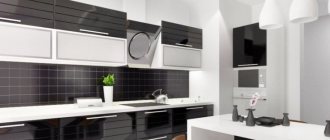Ergonomics is the science of optimal selection and arrangement of objects to ensure maximum comfort, ease of use and safety. Not only work spaces, but also home spaces should be ergonomic. You cannot sacrifice convenience for the sake of spectacular appearance. Ideally, you need to find a compromise so that aesthetics are combined with ergonomics. To paraphrase a well-known proverb, let’s formulate an important rule of modern design: measure seven times, decorate once.
Dimensions are key in ergonomics. For example, if the furniture is too low or too high, this is fraught not only with discomfort, but also with harm to health. If objects are located too close to each other, this makes the area uncomfortable and unsafe (increased risk of injury).
So, measure and think... To find the right solution, you need to master the formula. What are the basic principles of living room ergonomics? There are few of them and they are quite simple.
Distance between objects
1.5-2 meters free . Only in this case will entry and exit from the room be both safe and convenient.
If there is a dining area in the living room, the distance between it and the sofa area should be at least 1 meter , and better - from 1.5 meters.
The width of any passage areas must be at least 70-76 cm .
Inside the sofa area, the distance between objects should be 45-50 cm . Approximately this amount needs to be planned between a sofa and a coffee table, a table and an armchair, etc. This allows you to maneuver more or less unhindered and leaves room for your legs. Larger distances are also undesirable: for example, if there is more than 50 cm between the sofa and the table, it will become difficult to use the latter.
However, it is better to place the seats one meter apart from each other, but not more than three (we are talking about seats outside the same sofa). If this gap is larger, it is difficult for people sitting at different points to have a general conversation.
Rule No. 1 - “Working Triangle Rule”
When designing and planning a kitchen, it is necessary to remember the “working triangle” - the correct and sequential arrangement of three zones - storage, processing and cooking areas.
There are six options for placing work areas, and, accordingly, six types of kitchen layouts. They were described in detail in the article: “Kitchen layout and work triangle.” Now we just recall a simple rule:
Ideally, work areas should form a regular triangle. The length of its sides should be 1.2-1.6 meters, and the sum of the lengths of the sides should be 3.5-6.5 meters - this arrangement ensures ergonomics, convenience and free movement around the kitchen.
In the photo: the kitchens of Cesar Meg and Aster Cucine Opera.
Requirements for basic furniture in the sofa area
Sofas that are too low are harmful, especially for older people. If the process of getting up from the sofa is accompanied by even minimal difficulties, such furniture is anti-ergonomic.
The ideal height of the sofa is one at which the knees of the person sitting are bent at a right angle.
An excessively high and/or deep sofa is also undesirable. It is important that the legs of a sitting person (including those reclining) are on the floor and not hanging in the air. The usual sofa seat depth is 50-60 cm, but there are more. When choosing, an individual approach is required: the higher the family members, the deeper the seats, and vice versa.
If you have problems with your neck and spine, you should look for a sofa with the highest backrest possible. True, such things are not in fashion now. But there are ergonomic transforming models with a lifting backrest and headrest - this option is certainly worth attention.
The chairs, of course, must have armrests. However, like sofas.
The height of the coffee table should be close to the height of the sofa. It is more convenient when the table is slightly lower (by 10-12 cm, no more).
A miniature coffee table looks good, but functionally and ergonomically it is inferior to a large one. The classic rule: the length of the table should be at least half the length of the sofa. In this case, it will be easier to reach the table from different points in the zone.
Optional, but desirable: furniture for an ergonomic living room
The presence of so-called side tables (they are also called side tables) makes the area much more favorable. An additional element is necessary so that you don’t have to get up from the sofa and reach for the coffee table every time. Put away a book, put down a cup of drink, put down the phone - the side table never sits idle.
An ottoman, a banquette, a bench - something just below the sofa and armchair so that you can place your outstretched legs. The stand allows your legs to rest and your body to relax.
If you plan to spend a lot of time in the living room and sit for a long time, it is worth considering the presence of furniture that allows you to take a “reclining” position. It relieves stress from the muscles. For example, a daybed, chaise longue or L-shaped sofa will do.
Distance and height of the TV
The TV should be located far enough from the place from which it is viewed most often. The correct distance depends on the screen size. Or vice versa: the screen size is selected depending on the existing distance.
The formula is: optimal distance = screen size * 3.
So, if the diagonal of the TV is 108 cm, the sofa should be placed three meters from it.
Placing a large TV too close can strain your eyes and may have a negative impact on your vision. But an excessively small screen is also unhelpful, as it forces your eyes to strain.
The shorter the distance, the smaller the TV
Even more important is the height of the screen . If you hang it too high, you will have to raise your head, straining your neck. Watching TV for a long time in this position can cause headaches, physical fatigue, and severe discomfort in the neck and back. Ideally, the TV is located exactly opposite the person sitting. In this case, the middle of the screen is approximately at eye level.
The screen is too large and is positioned higher than it should be.
Correct size and height
You need to position the TV panel so that you don’t have to keep your head turned to the side to watch it (this can also be harmful to your health). It is necessary to create conditions so that you can watch TV directly.
This area is not suitable for prolonged TV viewing
Kitchen ergonomics, why is it needed?
A workspace should be comfortable for the person who will be working there, right? Moreover, precisely for him. Not just for a person, but specifically for the person who will most often cook in the kitchen.
Basic principles of kitchen ergonomics
Therefore, it is important to organize the workspace in the kitchen so that it is as convenient as possible. There are a number of aspects that need to be taken into account. This:
- workplace design
- dimensions
- relative position of all elements
All this must correspond to the psychophysiological, anthropometric and, of course, physiological data of a particular person.
Modern custom kitchens can even take into account the character of the person who will use them.
Research in the field of ergonomics is carried out by many leading institutions in the world. Their research confirms the main thing - the effectiveness of the kitchen as a workspace depends not so much on the availability of usable space, but mainly on the correct layout of this area.
In addition, if the furniture in the kitchen is of the correct size and dimensions, it is more convenient and safer to use. Let's look at an example. What should be the width of the countertop in the kitchen in accordance with the width of the upper cabinets so that it is comfortable for a woman of average height to work on it?
The diagram clearly shows that in picture “A”, it is inconvenient for a person to work on a tabletop 60 cm wide, since he will constantly touch the top cabinet with his head.
Lamps
An additional lamp (perhaps more than one) should definitely be placed in the sofa area, hanging it on the wall, placing it on the floor or installing it on a side table. The ability to illuminate an area at any time (with the general lighting turned off) adds a lot of points to the convenience of the living room.
***
That's all the basic rules of living room ergonomics. There is no need to obey them unquestioningly. Compliance with them is a matter of choice. However, it is definitely worth knowing about these basic principles.
Picasso spoke wonderfully about this: “Learn the rules like a professional, so that you can break them like an artist.” I wish you creative success!
Author: Evgenia Taranova
Correct kitchen ergonomics, what is it?
Ergonomics is, in fact, a whole science that was created in order to study the range of typical human actions or movements in the kitchen and in other rooms. Ergonomics is a science that allows you to think through and calculate everything from the standpoint of comfort and convenience in the kitchen.
What is all this for?
In order to determine the optimal combination of height, width, depth and dimensions of other parameters necessary for comfortable and safe work in the kitchen.
Ergonomics is needed in order to reduce the load, the number of movements, make work easier in the kitchen and, most importantly, take into account the characteristics of a particular person (his height and dimensions), for all this.
Ergonomic rules help reduce the number of movements and make work in the kitchen easier!
Ergonomics allows you to ensure that in your kitchen everything is at hand. All you have to do is turn around and extend your hand. You don’t have to bend over, get on all fours, or look for a stool so that you can stand on it and look for something on the top shelf for a long time.
Such kitchens are also called smart, that is, they take into account all the basic principles of ergonomics, and also use modern fittings, furniture handles and guides.
But, in addition, ergonomics takes into account the personal characteristics of each individual person using the kitchen. Let's talk about this in more detail.











